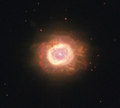File:Campbell's Star (9780444466).png
Campbell's_Star_(9780444466).png (565 × 508 pixels, file size: 466 KB, MIME type: image/png)
Captions
Captions
Summary
[edit]| DescriptionCampbell's Star (9780444466).png |
English: Edit 2013 Dec 09: Thinking more about this, I have decided that I am confused. This is a Wolf-Rayet central star with a planetary nebula, but the star is less massive than other classes of Wolf-Rayet stars. Massive stars have ejecta shells around them rather than planetary nebulas. However, it looks strange to me. Not necessarily just a planetary nebula. Could this be some kind of combination of ejecta shell plus planetary nebula? Anyway, I don't know quite what I am talking about here. After processing so many images of planetary nebulas I have ended up reading and learning far more than I ever thought I would but I can hardly claim to be educated on the matter.
Campbell's star is another Wolf-Rayet star with a nebula surrounding it. Conveniently, ESA published an article about it on the same day I decided to process this and you can read about it here. By coincidence I was rummaging through the HLA and decided I wanted to do this object but then realized I had just been looking at that ESA release maybe an hour earlier without realizing I was looking at the same thing. Processing sure makes a difference in how things can appear. It just looks like an oval without much detail in the HLA previews. I feel like a bit of a cheater because once someone else has taken a shot at it, it becomes a lot easier to find little things you'd like to fine tune beyond what your predecessor did. I probably wouldn't have pushed it as far as I could go without an example to work with. One thing I did notice without any help was that there were some interesting structures visible only in some NICMOS data, here appearing as the most red areas. What do your near-infrared eyes see, NICMOS? The list of data is awkward. All of these were from WFPC2 PC except for the f212n filter. The blue channel is just a quick median stack without much else while the red and green channels received special care. Red: NICMOS f212n+f953n+f673n+f658n Green: f656n+f631n Blue: f588n+f502n+f487n+f375n North is NOT up. |
| Date | Taken on 16 September 2013, 16:35:12 |
| Source | Campbell's Star |
| Author | geckzilla |
| Flickr sets InfoField | all astronomy; Hubble Processing; Planetary Nebulas |
| Flickr tags InfoField | hubble; star; hla; nebula; campbellsstar; hd184738 |
Licensing
[edit]- You are free:
- to share – to copy, distribute and transmit the work
- to remix – to adapt the work
- Under the following conditions:
- attribution – You must give appropriate credit, provide a link to the license, and indicate if changes were made. You may do so in any reasonable manner, but not in any way that suggests the licensor endorses you or your use.
| This image was originally posted to Flickr by geckzilla at https://flickr.com/photos/54209675@N00/9780444466. It was reviewed on 18 February 2024 by FlickreviewR 2 and was confirmed to be licensed under the terms of the cc-by-2.0. |
18 February 2024
File history
Click on a date/time to view the file as it appeared at that time.
| Date/Time | Thumbnail | Dimensions | User | Comment | |
|---|---|---|---|---|---|
| current | 02:27, 18 February 2024 |  | 565 × 508 (466 KB) | OptimusPrimeBot (talk | contribs) | #Spacemedia - Upload of https://live.staticflickr.com/3748/9780444466_95b790aa0b_o.png via Commons:Spacemedia |
You cannot overwrite this file.
File usage on Commons
There are no pages that use this file.
Metadata
This file contains additional information such as Exif metadata which may have been added by the digital camera, scanner, or software program used to create or digitize it. If the file has been modified from its original state, some details such as the timestamp may not fully reflect those of the original file. The timestamp is only as accurate as the clock in the camera, and it may be completely wrong.
| Width | 980 px |
|---|---|
| Height | 980 px |
| Compression scheme | Uncompressed |
| Number of components | 1 |
| Horizontal resolution | 72 dpi |
| Vertical resolution | 72 dpi |
| Image width | 950 px |
| Image height | 950 px |
| Color space | sRGB |
| Bits per component | 8 |
| Software used | |
| Date and time of digitizing | 12:35, 16 September 2013 |
| File change date and time | 17:48, 16 September 2013 |
| Date metadata was last modified | 17:48, 16 September 2013 |
| Unique ID of original document | xmp.did:49519B88BC1DE311A431E6309F8A474F |
| Contact information |
|
